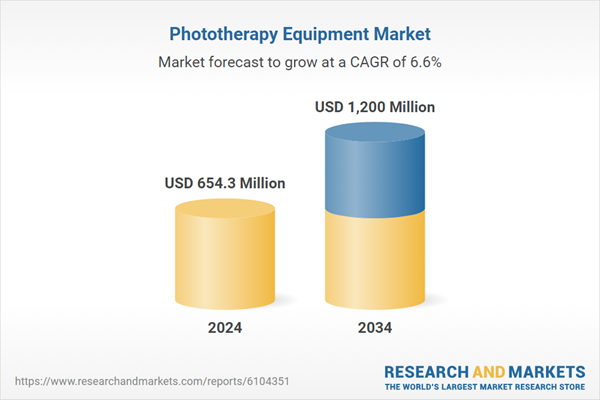The widespread adoption of these devices is reinforced by the growing healthcare infrastructure that prioritizes improved treatment for newborns and dermatological conditions. Advancements in phototherapy systems, including LED-based technology, wearable solutions, and precision wavelength delivery, have made these treatments safer and more effective, particularly by minimizing heat exposure and enhancing user comfort.
Devices using specific bands of light, such as UV, red, or blue, have shown significant therapeutic effects by triggering targeted biological responses, such as bilirubin breakdown in newborns or inflammation reduction in chronic skin diseases. These wavelengths are carefully selected to penetrate the skin at varying depths, allowing for precise treatment of specific conditions without damaging surrounding tissue. UV light is particularly effective in managing autoimmune skin disorders like psoriasis by slowing down excessive skin cell growth. Red light, known for its anti-inflammatory properties, supports tissue repair and reduces irritation, making it useful for eczema and wound healing.
In 2024, LED-based systems led the market with a valuation of USD 361.4 million. These devices are favored for their energy efficiency, low heat output, and extended operational life, making them particularly safe for neonates. Their growing use in both clinical and home settings is largely due to their portability and proven outcomes in treating dermatological disorders like vitiligo, psoriasis, and acne. The ability to deliver controlled, precise, and uniform light therapy with minimal side effects is positioning LED-based solutions as a preferred choice among healthcare providers.
The mobile phototherapy device segment is projected to reach USD 748.1 million by 2034. These mobile systems offer ease of use, operational flexibility, and compatibility with both healthcare facilities and at-home treatment environments. Their utility in treating neonatal jaundice is significant, particularly because mobility enhances treatment accessibility and efficiency. In the field of dermatology, these portable units are ideal for outpatient clinics, enabling more targeted care without requiring fixed installations. As more patients opt for home-based care solutions, the demand for mobile phototherapy equipment continues to climb due to cost savings and convenience.
U.S. Phototherapy Equipment Market accounted for USD 204.6 million in 2024. The country maintains a strong foothold in the phototherapy space due to its well-developed healthcare infrastructure, high prevalence of skin conditions, and continued focus on neonatal treatment solutions. Devices such as fiber optic systems and advanced LED units are increasingly utilized in both hospital settings and home care, supported by a rise in non-invasive treatment preferences and heightened awareness. As a result, demand in the U.S. is fueled by consistent medical advancements and the growing emphasis on patient comfort and affordability.
Key players actively shaping the Phototherapy Equipment Market include SolRx, Ibis Medical, Natus, Neotech, PHOENIX, GE HealthCare, DAVID, UVBioTek, ATOM MEDICAL, MEDI WAVES, OKUMAN, Phothera, NARANG MEDICAL LIMITED, and PHILIPS. To enhance their presence, companies in the phototherapy equipment market are investing heavily in product innovation, focusing on LED technology, wearable light therapy, and systems offering personalized wavelength control. Several players are expanding their global distribution networks and entering strategic partnerships with hospitals and clinics to broaden their customer base.
Additionally, many are integrating IoT and digital monitoring capabilities into devices to support remote care and improve patient outcomes. Marketing efforts emphasize non-invasive benefits and clinical success to attract both healthcare providers and end-users. Companies are also focusing on compact and home-use models to cater to the increasing demand for convenient and cost-effective therapy solutions.
Comprehensive Market Analysis and Forecast
- Industry trends, key growth drivers, challenges, future opportunities, and regulatory landscape
- Competitive landscape with Porter’s Five Forces and PESTEL analysis
- Market size, segmentation, and regional forecasts
- In-depth company profiles, business strategies, financial insights, and SWOT analysis
This product will be delivered within 2-4 business days.
Table of Contents
COMPANIES MENTIONED
The companies featured in this phototherapy equipment market report include:- ATOM MEDICAL
- DAVID
- GE HealthCare
- Ibis Medical
- MEDI WAVES
- NARANG MEDICAl LIMITED
- natus
- Neotech
- OKUMAN
- PHILIPS
- PHOENIX
- Phothera
- SolRx
- UVBioTek
Table Information
| Report Attribute | Details |
|---|---|
| No. of Pages | 130 |
| Published | June 2025 |
| Forecast Period | 2024 - 2034 |
| Estimated Market Value ( USD | $ 654.3 Million |
| Forecasted Market Value ( USD | $ 1200 Million |
| Compound Annual Growth Rate | 6.6% |
| Regions Covered | Global |
| No. of Companies Mentioned | 15 |









